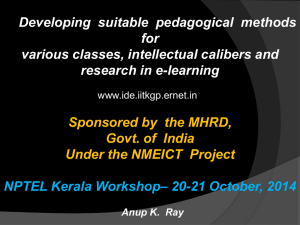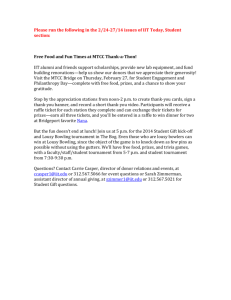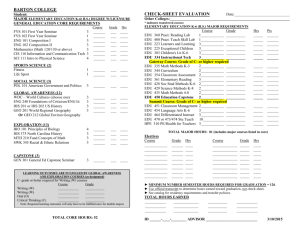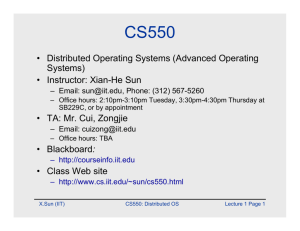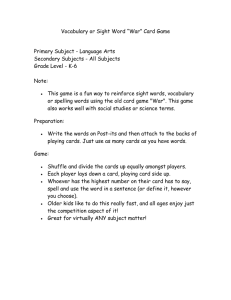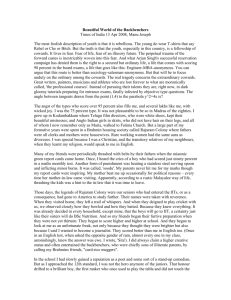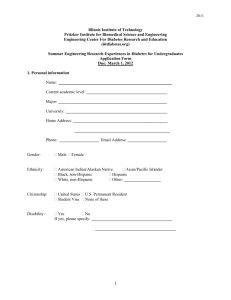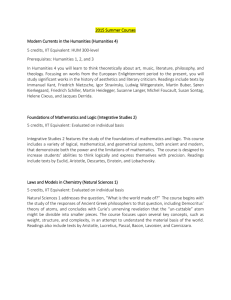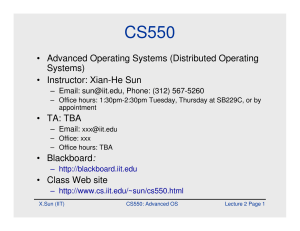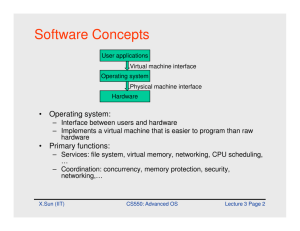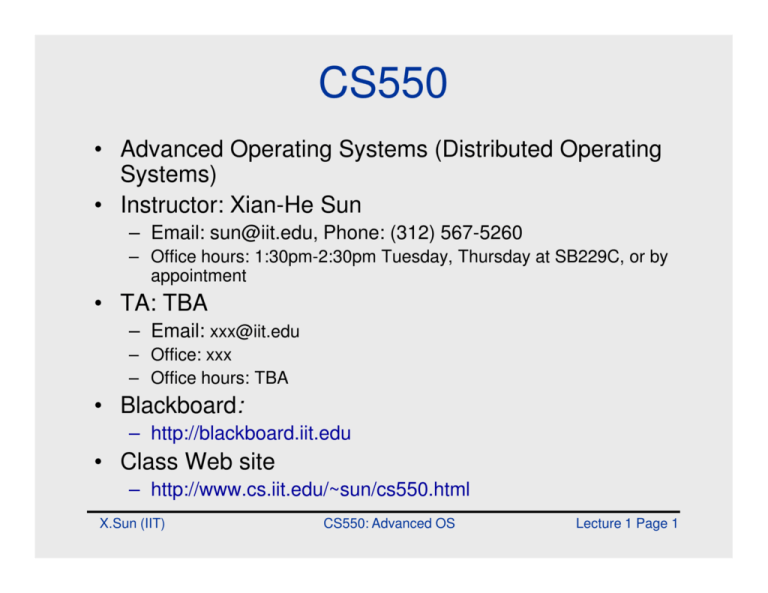
CS550
• Advanced Operating Systems (Distributed Operating
Systems)
• Instructor: Xian-He Sun
– Email: sun@iit.edu, Phone: (312) 567-5260
– Office hours: 1:30pm-2:30pm Tuesday, Thursday at SB229C, or by
appointment
• TA: TBA
– Email: xxx@iit.edu
– Office: xxx
– Office hours: TBA
• Blackboard:
– http://blackboard.iit.edu
• Class Web site
– http://www.cs.iit.edu/~sun/cs550.html
X.Sun (IIT)
CS550: Advanced OS
Lecture 1 Page 1
Outline
• Course information
• Key issues of distributed operating systems
• Hardware concepts
– Multiprocessors
– Multicomputers
– Distributed systems
• Software concepts
–
–
–
–
Uniprocessor OS
Distributed OS
Network OS
Middleware
X.Sun (IIT)
CS550: Advanced OS
Lecture 1 Page 2
What This Course is About
• Understanding the fundamental concepts of
distributed operating system, and distributed
systems in general
• Learning distributed programming techniques
– Multithreading, RPC, RMI, Sockets, MPI, etc.
• Understanding the general principles of
distributed paradigms
– MPI, JINI, NFS, Web Service, Grid, etc.
X.Sun (IIT)
CS550: Advanced OS
Lecture 1 Page 3
Prerequisite
• CS450 “Operating Systems”
• Familiar with
– Programming in C/C++ or Java
– UNIX tools and development environment
• Command
• Editors (vi, emacs), compilers (gcc), makefiles (GNU
make)
– Networking programming
• Sockets
• Multithreaded
• RPC, Java RMI
– Basic concepts of computer architecture
X.Sun (IIT)
CS550: Advanced OS
Lecture 1 Page 4
Course Materials
• Required:
– “Distributed Systems: Principles and Paradigms
(2nd edition)” by Tannenbaum and Van Steen,
Pearson/Prentice Hall 2007
• Recommended:
– “Distributed Systems: Concepts and Design (4th
edition)” by George Coulouris, Jean Dollimore,
and Tim Kindberg, Addison-Wesley, 2005
• Supplemental readings
– “Virtual Machines: Versatile Platforms for Systems
and Processes” by Jim Smith and Ravi Nair,
Morgan Kaufmann, 2005
X.Sun (IIT)
CS550: Advanced OS
Lecture 1 Page 5
Misc. Course Details
• You are expected to attend all of the lectures and
presentations
• Grading
– Written and programming assignments (35%): individual
work
– One exam (35%)
– Final project (30%): individual or group with 2-3 students
• Use the course blackboard
–
–
–
–
–
Announcements
Lecture notes
Assignments
Discussion
…
X.Sun (IIT)
CS550: Advanced OS
Lecture 1 Page 6
Policies
• Collaboration
– Encouraged for high level concepts and
understanding the courses materials
– but …..
• Cheating
– Copying all or part of another student's homework
– Allowing another student to copy all or part of your
homework
– Copying all or part of code found in a book,
magazine, the Internet, or other resource
X.Sun (IIT)
CS550: Advanced OS
Lecture 1 Page 7
Any Questions?
X.Sun (IIT)
CS550: Advanced OS
Lecture 1 Page 8
Personal Introduction
• Research interests
– Middleware
– High End Computing
– Performance Analysis and Modeling
• Research group:
– Scalable Computing Software Laboratory (SCS)
– http://www.cs.iit.edu/~scs/
– Weekly Research seminar
X.Sun (IIT)
CS550: Advanced OS
Lecture 1 Page 9
Distributed Computing at SCS
Many workstations are made available for graduate students
X.Sun (IIT)
CS550: Advanced OS
Lecture 1 Page 10
Scalable Computing Software (SCS) Lab.
Distributed
Optical Testbed
(Grid)
NU-C
UIC
ANL
NU-E
Star Tap
IIT
Uof C
NCSA/UIUC
Parallel Computers at SCS
I-WIRE
OMNI
Pervasive Computing
Environments at SCS
X.Sun (IIT)
CS550: Advanced OS
Lecture 1 Page 11
Scalable Systems
• A computer system is called scalable if it can
scale up to accommodate ever-increasing
performance and functionality demand
• A software is called scalable if it can maintain
its functionality and efficiency while the
underlying computer system and problem
scale up
X.Sun (IIT)
CS550: Advanced OS
Lecture 1 Page 12
Evolution of Computing
Bigger becomes even bigger
Smaller becomes ever smaller, & connected
Japan’s Earth Simulator
•640 processor nodes (PNs)
•Each PN is a system with 8
vector-type arithmetic
processors (APs)
•Peak performance 40Tflops
approx; 50m x 65m x 17m
1.4m x1m x 2m
X.Sun (IIT)
.
CS546
Lecture 1 Page 13
Scalable Computing
The way to high performance
The fastest
supercomputer in
November 2007
Scalable ultracomputer targeted
for 106,496
compute nodes
BlueGene/L is now
running with
212992 processors
and 478.2 TFlops
on LINPACK
Peak performance:
596 TFlops
BlueGene / L
X.Sun (IIT)
CS546
Lecture 1 Page 14
Multicore Add Another Dimension
IBM Multicore
• Cell
– 1 PPE and 8 SPEs
– Shared L2 cache
– EIB
• Power6
– Dual core
– 5 GHz
X.Sun (IIT)
CS546
Lecture 1 Page 15
Multi-Core
•
Motivation for Multi-Core
–
–
–
–
•
Exploits improved feature-size and density
Increases functional units per chip (spatial
efficiency)
Limits energy consumption per operation
Constrains growth in processor complexity
Challenges resulting from multi-core
–
Aggravates memory wall
•
Memory bandwidth
–
–
•
•
–
Need for parallel computing model and parallel
programming model
Pins become strangle point
•
•
–
Memory latency
Fragments L3 cache
Relies on effective exploitation of multiple-thread
parallelism
•
–
Way to get data out of memory banks
Way to get data into multi-core processor array
Rate of pin growth projected to slow and flatten
Rate of bandwidth per pin (pair) projected to grow
slowly
Requires mechanisms for efficient inter-processor
coordination
•
•
•
Synchronization
Mutual exclusion
Context switching
X.Sun (IIT)
CS546
Lecture 2 Page 16
16
Distributed Computing: What is the new
Supercomputers become
ever powerful
Communities of “Virtual
organizations” are
formed
No VO possesses all
required skills and
resources
From “community
sharing” to “information
grid”
X.Sun (IIT)
CS546
Lecture 1 Page 17
Integrated VOs: the Grid
Mimic the electrical power grid
Increased
Efficiency
Higher Quality
of Service
Increased
Productivity
Reduced
Complexity
& Cost
Improved
Resiliency
X.Sun (IIT)
CS546
Lecture 1 Page 18
The Challenge of Grid Computing
Virtualization and Resource Management
Many sources
of data, services,
computation
RM
Discovery
R
R
RM
Access
Registries organize
services of interest
to a community
RM
RM
Security
Security
service
service
Data integration activities
may require access to, &
exploration/analysis of, data
at many locations
X.Sun (IIT)
Security & policy
must underlie access
& management
decisions
CS546
RM
Resource management
is needed to ensure
progress & arbitrate
competing demands
Policy
Policy
service
service
Exploration & analysis
may involve complex,
multi-step workflows
Lecture 1 Page 19
Cloud Computing
Mimic the electrical power grid
Increased
Efficiency
Higher Quality
of Service
Increased
Productivity
Reduced
Complexity
& Cost
Improved
Resiliency
X.Sun (IIT)
CS546
Lecture 1 Page 20
What is Cloud Computing?
• A computing paradigm in which tasks are assigned to a
combination of connections, software and services
accessed over a network
• The network of servers and connections is collectively
known as the cloud
• Other terms
– Mesh Computing
– Elastic Cloud Computing
– Network Computing
X.Sun (IIT)
2009-1-21
CS546
Lecture 1 Page 21
21
What are the diff. between Cloud & Grid?
A commercial version of Grid computing
More likely under single management (VO)
More likely provide computing resources than resource
sharing
More like to serve lots of modest size jobs
billions of dollars being spent by the likes of Amazon, Google,
and Microsoft to create real commercial grids
The prospect of needing only a credit card to get on-demand
access to 100,000+ computers in tens of data centers
distributed throughout the world
X.Sun (IIT)
2009-1-21
CS546
Lecture 1 Page 22
22
Cloud: Integrated Resource
Provide virtual computing
environments on demand
X.Sun (IIT)
CS546
Lecture 1 Page 23
X.Sun (IIT)
CS546
Lecture 1 Page 24
Virtualization and Virtual Machine
• Virtual service and virtual machine: the key for data
center and Cloud computing
• Virtual machine (in distributed environment): A
hosting platform where each user can create and
operate in a private machine(s), based on
Grid/distribute infrastructure, achieving:
–
–
–
–
–
Virtualization
Isolation and Protection
Privacy
Accountability and QoS
On-demand creation and provisioning
X.Sun (IIT)
CS550: Advanced OS
Lecture 1 Page 25
Distributed (Dynamic) Virtual Machine
DVM
Virtual service node
DVM’
DVM Host
(physical)
X.Sun (IIT)
CS550: Advanced OS
Lecture 1 Page 26
Virtualization: Key Technique
•
Two-level OS structure
–
–
•
Strong isolation
–
–
–
–
•
Host OS
Guest OS
Administration isolation
Installation isolation
Fault / attack Isolation
Recovery, migration, and
reconfiguration
DVMS1
DVMSn
…
Guest OS
Guest OS
Virtual service node
–
–
–
DVM Service (DVMS)
Guest OS
Internetworking enabled
Host OS
One DVM host
Embedded Systems: What is the new
• Devices become
smaller and more
powerful
• Devices are
coordinated via network
• From “autonomous
computing” to
coordinated “humancenter computing”
X.Sun (IIT)
CS550: Advanced OS
Lecture 1 Page 28
Pervasive Computing
MIT’s view of pervasive computing
X.Sun (IIT)
CS550: Advanced OS
Lecture 1 Page 29
Evolution of Computing
Federated Communities
Virtualization
Standardization
Uneven Conditions
Remote Comm.
Coordination
High Availability
Security & Fault
Tolerance
Grid
Computing
Distributed
Computing
Mobile
Mobility
Mobile Network
Adaptive & Reflective
Energy Aware system
X.Sun (IIT)
Global
Smart Space
(Cloud)
Pervasive
Computing
Computing
Smart Space
Invisibility
Localized Scalability
Context Awareness
CS550: Advanced OS
Lecture 1 Page 30
Service Oriented Computing
Computing as a service
Started far
apart in
applications
&
technology
Have been
converging
WSRF
WS-I
Compliant
Technology
Stack
• Internet computing:
Convergence of Core Technology Standards allows
Common base for Business and Technology Services
Web service
• Grid computing:
Grid service and is merging with WS
• Pervasive computing:
Human centered service
• Mobile computing:
Phone service
X.Sun (IIT)
CS550: Advanced OS
Lecture 1 Page 31
Future Computing: Human-centered Service
A new IT booming is coming
They are
connected to
form `smart
space’
Grids link
`smart spaces’ to
support `global
smartness’
Devices
become smaller
and powerful
A device is
an entry of
the cyber
world
X.Sun (IIT)
CS550: Advanced OS
Lecture 1 Page 32
The Third Wave of Computing Revolutions
• Network, communication, and interconnectivity
• Begin in the late 90s until now
• Machine/machine, software/software,
people/people
• Anytime, anywhere, WWW
• The communications landscape is shifting
• Promising but a continued work
How do we get there?
– Many Challenges ahead!
X.Sun (IIT)
CS550: Advanced OS
Lecture 1 Page 33
Resource Management & Task Scheduling
• DVM provider selection:
– Among a set of DVM providers, which one should be
chosen to host an DVM?
• DVMS selection:
– Among a set of potential tenants (DVMSes), which
ones to host? (for QoS, resource utilization, security…)
• The Grid Harvest Service (GHS) System
– A long-term application-level performance
prediction and task scheduling system for nondedicated distributed (Grid) environments
– Reservation-based versus shared resources
– Good, but more issues, such as QoS, FT, need to solve
X.Sun (IIT)
CS550: Advanced OS
Lecture 1 Page 34
Processor-memory performance gap
• Processor performance
increases rapidly
• Intel TeraFlops chip, 2007
– Aggregate processor
performance much higher
100,000
Multi-core/many-core processor
10,000
Uni-rocessor
20%
1,000
52%
100
25%
10
1
1980
• Memory: ~9% per year
• Processor-memory speed
gap keeps increasing
Memory
1985
1990
1995
2000
2005
2010
Year
The Memory-wall problem requires
a rethinking of the design of OS
X.Sun (IIT)
60%
Source: Intel
Performance
– Uni-processor: ~52% until
2004, ~25% since then
– New trend: multi-core/manycore architecture
CS546
Source: OCZ
Lecture 1 Page 35
9%
Gordon
Moore’s Law
“the number of transistors
that can be fabricated on a
single integrated circuit at
a reasonable cost doubles
every year…”
• How?
– Material techniques such as extreme ultraviolet lithography (<100 nm)
• Corollary
– Processor speed doubles at same rate
• Problem
– Moore’s law almost hits its limitation
– Then , what
X.Sun (IIT)
is the impact? who and which technology will lead?
CS546
Lecture 1 Page 36
Any Questions?
X.Sun (IIT)
CS550: Advanced OS
Lecture 1 Page 37

